Best laptops for COMSOL | Unleashing the power of COMSOL Multiphysics on the go: navigating complex simulations and demanding analyses from anywhere requires the perfect mobile companion. But not all laptops are created equal when it comes to handling the computational muscle COMSOL demands. This guide dissects the top contenders, pinpointing the ideal laptops for conquering your COMSOL challenges – whether you’re an engineering pro tackling intricate fluid dynamics or a budding scientist unraveling the mysteries of the material world. So, buckle up, grab your coffee, and get ready to discover the best laptops for COMSOL, empowering you to push the boundaries of scientific exploration from the comfort of your desk or the heart of the field.
You may also be interested in this article. Best laptops for KeyShot

COMSOL laptop requirements
- Operating system: Windows 10/11, macOS 10.13 or later, or Linux Ubuntu 18.04 LTS or later
- Processor: Intel Core i5 or i7, AMD Ryzen 5 or 7 (or Xeon workstation processors for complex models)
- RAM: 16GB or more (32GB or more recommended for complex models)
- Storage: 256GB SSD or more (512GB or more recommended for complex models)
- Graphics card: Dedicated graphics card with 4GB of memory or more is recommended for hardware acceleration (OpenGL version 4.5 or later, DirectX version 11 or later)
Best laptops for COMSOL
- Apple MacBook Pro Laptop M3 Pro chip ($1,830)
- ASUS ProArt StudioBook 16 OLED Laptop ($2,734)
- MSI CreatorPro M15 Laptop ($1,099)
- Lenovo Legion 5 15.6″ Gaming Laptop ($1,394)
- HP Envy 17.3″ FHD Touchscreen Laptop ($1,979)
- Dell XPS 17 9710 Laptop ($1,999)
1. Apple MacBook Pro Laptop M3 Pro chip

| Model Name | MacBook Pro |
| Screen Size | 14.2 Inches |
| Hard Disk Size | 512 GB |
| Ram Memory Installed Size | 18 GB |
| Operating System | Mac OS |
| Graphics Coprocessor | Apple Integrated Graphics |
The MacBook Pro, particularly the versions powered by the M3 Pro or M3 Max chips, offers several features that make it an excellent choice for COMSOL users:
Properties of MacBook Pro
- Powerful Chipsets: Both the M3 Pro and M3 Max chips boast high-performance CPUs and GPUs, with the M3 Max providing even more extreme capabilities. These chips ensure smooth simulations and computations within COMSOL, especially for complex simulations requiring significant computational power.
- Extended Battery Life: With up to 18 hours of battery life, the MacBook Pro allows users to work on COMSOL projects for extended periods without needing to constantly search for power outlets. This feature is particularly useful for users who need to run simulations or analyses for extended durations.
- Brilliant Pro Display: The MacBook Pro’s Liquid Retina XDR display offers exceptional visual clarity and detail, which is advantageous for analyzing simulation results and visualizing complex data within COMSOL.
- Fully Compatible with Pro Apps: The MacBook Pro is compatible with a wide range of professional applications, including COMSOL, ensuring seamless integration and optimal performance for engineering and scientific tasks.
- Advanced Camera and Audio: The high-quality FaceTime HD camera and studio-quality microphone array facilitate clear communication during collaborative COMSOL sessions or virtual meetings.
- Connectivity Options: The MacBook Pro offers a variety of connectivity options, including Thunderbolt 4 ports and an HDMI port, allowing users to easily connect external monitors or peripherals for enhanced productivity while working with COMSOL.
- Security and Durability: With robust security features and a durable aluminum unibody enclosure, the MacBook Pro provides peace of mind to users concerned about data security and the longevity of their device.
In summary, the MacBook Pro’s combination of powerful hardware, advanced features, and compatibility with professional software makes it an excellent choice for COMSOL users who require reliability, performance, and flexibility in their computational work.
2. ASUS ProArt StudioBook 16 OLED Laptop
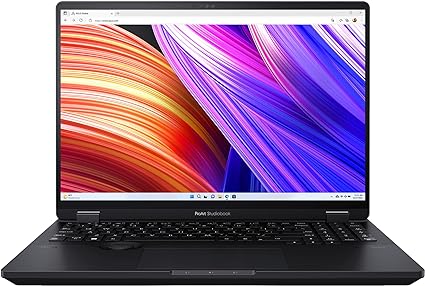
| Model Name | ProArt StudioBook 16 |
| Screen Size | 16 Inches |
| Color | Mineral |
| Hard Disk Size | 1 TB |
| CPU Model | Core i9 |
| Ram Memory Installed Size | 32 GB |
| Operating System | Windows 11 Home |
| Graphics Card Description | Dedicated |
| Graphics Coprocessor | NVIDIA GeForce RTX 4070 |
The ASUS ProArt StudioBook 16 OLED Laptop presents an impressive array of features that make it a strong contender for the title of “Best laptops for COMSOL.” Here’s why:
Properties of ProArt StudioBook 16
- Powerful Processor and GPU: The Intel Core i9-13980HX Processor with 24 cores and 32 threads, combined with the NVIDIA GeForce RTX 4070 Laptop GPU, ensures robust computational power. COMSOL Multiphysics, being a simulation software, heavily relies on CPU and GPU performance for complex calculations and rendering, and this laptop offers top-tier components in both departments.
- High-Resolution OLED Display: The 16” OLED 3.2K touch display with a 120Hz refresh rate and 0.2ms response time provides a stunning visual experience. For COMSOL users, the high resolution, color accuracy (100% DCI-P3, Pantone validated), and wide color gamut (Delta E <2) are crucial for visualizing simulation results accurately and effectively.
- Stylus Support: The inclusion of a 4096 pressure-level MPP 2.0 stylus support enhances the usability of the laptop for COMSOL users who may need to sketch out ideas, annotate results, or interact with simulations directly on the screen.
- Fast Storage and Memory: The 1TB M.2 NVMe PCIe 4.0 Performance SSD and 32GB DDR5 SO-DIMM Memory ensure swift access to simulation data and smooth multitasking capabilities, which are essential for handling large-scale simulations and data sets in COMSOL.
- Military-Grade Durability: The laptop adheres to the US MIL-STD 810H military-grade standard, ensuring durability and reliability even in challenging working environments, making it suitable for users who require portability without compromising on robustness.
Overall, the ASUS ProArt StudioBook 16 OLED Laptop offers a potent combination of processing power, display quality, stylus support, storage, memory, and durability, making it an excellent choice for professionals and researchers working with COMSOL simulations.
3. MSI CreatorPro M15 Laptop
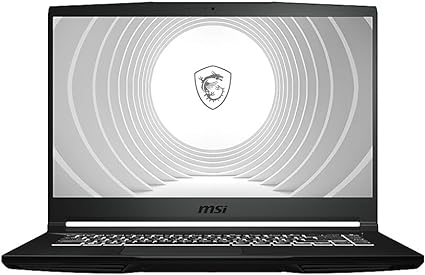
| Model Name | CreatorPro M15 A11UIS-1292US |
| Screen Size | 15.6 Inches |
| Color | Black |
| Hard Disk Size | 512 GB |
| CPU Model | Core i7 |
| Ram Memory Installed Size | 16 GB |
| Operating System | Windows 11 Pro |
| Special Feature | Thin Bezel |
| Graphics Card Description | RTX A1000 Dedicated |
The MSI CreatorPro M15, with its robust specifications and features, makes it a commendable choice for running COMSOL simulations effectively:
Properties of CreatorPro M15
- Powerful Processor: The 13th Gen Intel Core i7 processor provides substantial processing power, which is crucial for running complex simulations on COMSOL Multiphysics. With its 8 cores, the Intel Core i7-11800H can handle demanding computational tasks efficiently, ensuring smooth operation of simulations.
- Graphics Performance: The inclusion of the RTX A1000 graphics card enhances the laptop’s capability to handle graphics-intensive simulations and visualization tasks. COMSOL simulations often involve intricate graphical representations of data and models, and the RTX A1000 ensures smooth rendering and computation of these visuals.
- High-Resolution Display: The QHD+ display with a 16:10 aspect ratio and 100% DCI-P3 color gamut provides excellent visual clarity and color accuracy. This is beneficial for analyzing simulation results and examining detailed models within COMSOL, allowing users to discern subtle variations and trends in their simulations.
- Ample Memory and Storage: With 16GB DDR4 RAM and a 512GB NVMe SSD, the laptop offers sufficient memory and storage capacity to handle large simulation datasets and temporary files generated during computations. This ensures that users can work efficiently without being hindered by storage or memory constraints.
- User-Friendly Design: The Creator M16’s design features, such as the 180° lay-flat capability and ultra-thin bezels, enhance usability and facilitate collaboration. Users can easily share their simulation results and collaborate with colleagues or teammates without obstruction, fostering productivity and seamless communication.
- Windows 11 Pro: The inclusion of Windows 11 Pro further enhances the user experience by providing a stable and efficient operating system environment for running COMSOL and other productivity software.
Overall, the MSI CreatorPro M15 combines powerful hardware specifications, a high-resolution display, ample memory and storage, and user-friendly design elements, making it an excellent choice for users looking for a laptop optimized for COMSOL simulations and other computational tasks.
4. Lenovo Legion 5 15.6″ Gaming Laptop
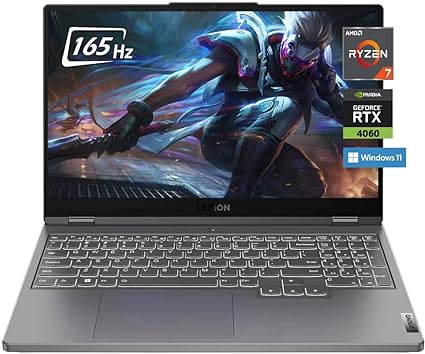
| Model Name | Legion 5 15ARP8 |
| Screen Size | 15.6 Inches |
| Hard Disk Size | 2 TB |
| CPU Model | AMD Ryzen 7 |
| Ram Memory Installed Size | 32 GB |
| Operating System | Windows 11 |
| Special Feature | Backlit Keyboard |
| Graphics Card Description | NVIDIA GeForce RTX 4060 |
The Lenovo Legion 5 laptop with the provided specifications appears to be a solid choice for running COMSOL simulations effectively. Here’s why:
Properties of Legion 5
- Powerful Processor: The AMD Ryzen 7 7735HS processor, with its 8 cores and high clock speed of up to 4.75GHz, provides ample computing power necessary for handling complex simulations in COMSOL.
- Ample Memory: With 32GB of DDR5 4800MHz RAM, the laptop offers sufficient memory to handle large-scale simulations without experiencing slowdowns or bottlenecks.
- Fast Storage: The 2TB solid-state drive (SSD) ensures fast read and write speeds, which is essential for loading simulation data quickly and efficiently.
- High-Resolution Display: The 15.6″ IPS Anti-Glare WQHD display with a resolution of 2560×1440 and a refresh rate of 165Hz provides a crisp and clear viewing experience, allowing for detailed analysis of simulation results.
- Dedicated Graphics: The NVIDIA GeForce RTX 4060 graphics card offers additional computational power, especially for tasks that can benefit from GPU acceleration, which is common in many simulation applications, including COMSOL.
- Versatile Connectivity: The variety of ports, including USB, HDMI, USB-C, and Ethernet, provide ample connectivity options for external devices and peripherals, facilitating data transfer and collaboration.
- Integrated Webcam: The integrated 720p webcam with a privacy shutter adds convenience for virtual meetings, presentations, or collaborative sessions related to COMSOL simulations.
- Windows 11 Operating System: While the choice of operating system may not directly impact COMSOL’s performance, having the latest Windows OS can ensure compatibility with the latest software updates and features.
Overall, the combination of powerful hardware specifications, high-resolution display, dedicated graphics, ample memory and storage, and versatile connectivity options makes the Lenovo Legion 5 a suitable choice for professionals or researchers working with COMSOL simulations.
5. HP Envy 17.3″ FHD Touchscreen Laptop
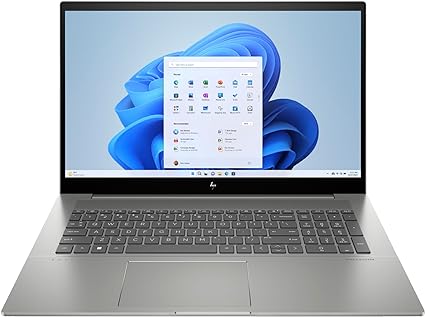
| Model Name | Envy 17-CR1000 |
| Screen Size | 17.3 Inches |
| Color | Platinum Silver |
| Hard Disk Size | 4 TB |
| CPU Model | Core i7 Family |
| Ram Memory Installed Size | 64 GB |
| Operating System | Windows 11 Pro |
| Special Feature | Backlit Keyboard |
| Graphics Card Description | NVDIA GeForce RTX 3050 Dedicated |
The HP Envy 17 with the specifications provided would indeed be an excellent choice for running COMSOL simulations, and here’s why:
Properties of Envy 17
- Powerful Processor: The 13th Generation Intel Core i7-1355U 10-Core Processor with up to 5.0 GHz clock speed and 12 threads offers significant computational power, which is crucial for handling complex simulations in COMSOL.
- Ample Memory: With 64GB of DDR4 SDRAM running at 3200 MHz, the laptop provides abundant memory capacity, allowing for large simulations and multitasking without experiencing slowdowns.
- High-Speed Storage: The 4TB PCIe NVMe Solid State Drive ensures rapid data access and transfer speeds, enabling quick loading of simulation data and results.
- Dedicated Graphics: The NVIDIA GeForce RTX 3050 with 4GB GDDR6 graphics provides additional computational power specifically for graphics-intensive tasks, which can enhance visualization and rendering capabilities within COMSOL.
- Large, High-Resolution Display: The 17.3″ FHD IPS touchscreen display with 100% sRGB coverage offers ample screen real estate and high resolution for viewing and interacting with simulation models in detail.
- Versatile Connectivity: The laptop offers various ports including Thunderbolt 4, USB 3.1, HDMI 2.1, and a headphone/microphone combo jack, ensuring compatibility with different peripherals and external displays commonly used in engineering workflows.
- Wireless Connectivity: Wi-Fi 6E AX211 and Bluetooth 5.3 provide fast and reliable wireless connectivity options for accessing online resources and connecting with other devices.
- Additional Features: Features like the backlit keyboard with a numpad, HP True Vision 5MP IR camera with Privacy Shutter, and a decent 4-cell lithium-ion battery further enhance usability and convenience for engineering professionals using COMSOL.
Overall, the combination of powerful hardware, ample memory and storage, dedicated graphics, and a high-quality display makes the HP Envy 17 well-suited for running COMSOL simulations efficiently and effectively.
6. Dell XPS 17 9710 Laptop
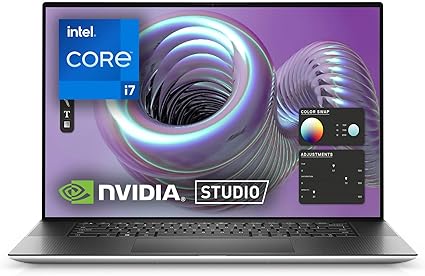
| Model Name | XPS 17 9710 |
| Screen Size | 17 Inches |
| Color | Silver |
| Hard Disk Size | 1 TB |
| CPU Model | Core i7 Family |
| Ram Memory Installed Size | 16 GB |
| Operating System | Windows 11 Home |
| Special Feature | Backlit Keyboard, Fingerprint Reader, Memory Card Slot |
| Graphics Card Description | NVIDIA GeForce RTX 3050 Dedicated |
The Dell XPS 17 9710 laptop is an excellent choice for running COMSOL, a multiphysics simulation software, due to several key features:
Properties of Dell XPS 17
- Powerful Performance: The 11th Generation Intel Core i7 processors and NVIDIA RTX graphics are ideal for handling the computational demands of COMSOL. The combination of a high-performance CPU and a powerful GPU ensures that simulations run smoothly and efficiently, significantly reducing computation time.
- Stunning Screen: The 16:10 4-sided InfinityEdge display offers an expansive and detailed view, which is essential for analyzing complex simulations and models. The higher vertical space provided by the 16:10 aspect ratio is particularly beneficial for viewing detailed graphs and data.
- Eyesafe Technology: The built-in Eyesafe technology reduces harmful blue light without compromising color accuracy, which is important for prolonged usage. This feature helps to minimize eye strain during long simulation sessions.
- Creative Potential: The GeForce RTX 30 Series graphics with AI-acceleration support top creative applications, making this laptop versatile for other demanding tasks such as rendering, modeling, and visualizations often used in conjunction with COMSOL.
- Immersive Sound: The quad speaker design and Waves Nx 3D audio provide an immersive audio experience, which, while not directly related to COMSOL, enhances the overall user experience, especially when using multimedia applications or reviewing simulation results that include audio components.
These features collectively make the Dell XPS 17 9710 a robust and versatile tool for COMSOL users, capable of handling intensive computational tasks while providing an excellent visual and user-friendly experience.
Conclusion – Best laptops for COMSOL
Choosing the “best” laptop for COMSOL ultimately depends on your specific needs and budget. Consider the complexity of your simulations, your tolerance for portability, and any additional software needs you might have. Weigh the pros and cons of different processor speeds, RAM capacities, and graphics capabilities before making your final decision. Remember, future-proofing your purchase with upgradeable components might be worthwhile for long-term COMSOL use. By prioritizing your specific needs and researching available options, you’ll be well on your way to finding the perfect laptop to power your COMSOL simulations and push the boundaries of your research.
FAQs – Best laptops for COMSOL
COMSOL Multiphysics is a powerful tool for scientific and engineering simulations, but its demanding nature can leave laptop users in a quandary. Fear not, intrepid modelers! This comprehensive FAQ tackles everything you need to know about finding the perfect mobile workstation for running COMSOL seamlessly, from processor prowess to thermal fortitude. Dive in and discover the secrets to unleashing the full potential of COMSOL, wherever your research takes you.
In this section, we will look for answers to the following frequently asked questions about laptops for COMSOL.
- How much RAM do I need for COMSOL?
- Which processor is best for COMSOL?
- Does COMSOL need graphics card?
- How to make COMSOL run faster?
- What is the best workstation for Comsol?
- How many cores does Comsol use?
1. How much RAM do I need for COMSOL?
Determining the ideal amount of RAM for COMSOL depends on several factors, making it tough to give a one-size-fits-all answer. However, I can guide you in making an informed decision based on your needs:
Minimum requirements:
- COMSOL officially recommends at least 4GB of RAM: This is the bare minimum to get started, but it’s unlikely to suffice for complex models or simulations.
- The system requirements page suggests 2-20GB of disk space: While disk space doesn’t directly impact RAM, it’s helpful to know as large models might involve swapping to disk, impacting performance.
Factors to consider for RAM:
- Model complexity: Larger models with finer meshes and multiple physics couplings will require more RAM.
- Solver settings: Using direct or iterative solvers often consumes more RAM than Krylov solvers.
- Post-processing needs: Extensive post-processing calculations can demand additional RAM.
- Operating system: Consider if you’re running additional memory-intensive programs alongside COMSOL.
Recommendations:
- For basic 2D or small 3D models: 8GB of RAM might be sufficient, but 16GB is recommended for a smoother experience.
- For complex 3D models or intensive simulations: 32GB of RAM is a good starting point. Opt for 64GB or more if dealing with massive models or memory-intensive post-processing.
Additional tips:
- Monitor memory usage in COMSOL: The software displays physical and virtual memory usage in the lower right corner. Watch for spikes or near-full utilization, indicating insufficient RAM.
- Utilize swap space efficiently: Ensure your swap partition is on a fast SSD for smoother operation when exceeding available RAM.
- Optimize model size and settings: Minimize mesh size, consider coarser elements where appropriate, and optimize solver settings to reduce memory consumption.
2. Which processor is best for COMSOL?
There’s no single “best” processor for COMSOL as it depends on your specific needs and budget. However, I can guide you to determine the optimal choice based on factors like:
Your typical COMSOL workload:
- Complexity of models: Do you work with large, complex models with extensive multiphysics coupling?
- Typical problem size: How many meshes and unknowns are involved in your models?
- Solution time: Can you tolerate longer simulations, or do you need fast results?
Budget:
- High-end processors offer better performance but come at a steeper price.
Here’s a breakdown of your options:
High-end CPUs:
- Intel Xeon Scalable Processors: Ideal for heavy computation with up to 40 cores and high clock speeds. Suitable for complex, large-scale models and fast simulations.
- AMD Ryzen Threadripper™: Another excellent choice for heavy workloads, offering competitive core counts and performance at a slightly lower price than Xeon Scalable.
Mid-range CPUs:
- Intel Xeon® W: A well-rounded option for multiphysics simulations, balancing performance and cost. Great for single-CPU computers with decent core counts and clock speeds.
- AMD Ryzen™ 5 & 7: Good value for budget-conscious users, offering solid performance for smaller models and everyday tasks.
Consumer-grade CPUs:
- Intel Core™ i7 & i9: Can handle smaller COMSOL models efficiently, especially if budget is a major concern. Not ideal for large, complex simulations.
Additional factors to consider:
- RAM: COMSOL is RAM-intensive, so ensure sufficient capacity (32GB or more recommended for complex models).
- Storage: Opt for fast SSDs for quicker loading and saving of models.
- Operating system: COMSOL supports Windows, macOS, and Linux. Choose the one you’re most comfortable with.
Ultimately, the best approach is to:
- Identify your typical COMSOL usage: Complexity, size, and desired solution time.
- Set a budget: Determine how much you’re willing to spend.
- Research specific processors: Compare core counts, clock speeds, and benchmarks for your chosen budget range.
- Seek expert advice: Consider consulting COMSOL experts or hardware vendors for personalized recommendations.
Remember, there’s no one-size-fits-all solution. By understanding your needs and exploring options, you can choose the processor that best optimizes your COMSOL experience.
3. Does COMSOL need graphics card?
While COMSOL Multiphysics doesn’t necessarily require a graphics card, having one can significantly improve your experience in several ways:
Performance: A dedicated graphics card offloads the rendering computations from your CPU, leading to smoother visualization and faster model manipulation, especially for complex models.
Quality: For high-resolution visuals and advanced effects like ray tracing, a good graphics card with enough memory (2GB or more recommended) is crucial.
Features: Certain features in COMSOL, like the “Optimize for Quality” setting in graphics preferences, require OpenGL version 2.1 or later and may not be accessible without a dedicated card.
Compatibility: COMSOL recommends modern AMD or NVIDIA GPUs for optimal performance and stability. They even provide a list of rigorously tested compatible cards on their website.
However, COMSOL can still function with integrated graphics or software rendering, albeit with reduced performance and limited capabilities. This might be sufficient for basic tasks and smaller models, but for demanding simulations and high-quality visuals, a dedicated graphics card is highly recommended.
Ultimately, the decision depends on your specific needs and usage of COMSOL. If you work with complex models, require smooth visualization, and want access to all features, a good graphics card is a worthwhile investment.
4. How to make COMSOL run faster?
Making COMSOL run faster involves balancing accuracy with computational efficiency. Here are some strategies you can consider:
Hardware:
- RAM: Ensure you have enough RAM (generally 16GB or more) to handle your model size and complexity. COMSOL relies heavily on RAM for calculations.
- CPU: Choose a CPU with high clock speed and multiple cores. Consider upgrading if your current CPU struggles with complex models.
- SSD: Using an SSD over a traditional hard drive can significantly improve loading and saving times.
Software Settings:
- Solver: Choose the appropriate solver for your problem. COMSOL offers several solvers with varying speeds and accuracy levels. Consult the COMSOL documentation for solver recommendations.
- Tolerances: Adjust solver tolerances (absolute or relative) based on your desired accuracy level. Lower tolerances often require more compute power but provide more precise results.
- Step size: Experiment with different step sizes within your solver settings. Decreasing the step size improves accuracy but increases computation time.
- Meshing: Optimize your mesh to balance accuracy and performance. Use coarser meshes in areas with less variation and finer meshes near boundaries or regions with sharp gradients. COMSOL offers adaptive meshing options as well.
- Parallelization: Utilize multi-core processing if your computer supports it. COMSOL can leverage multiple cores to significantly speed up computations.
- Background processing: Run simulations in the background while working on other tasks to avoid disrupting your workflow.
Model Optimization:
- Simplify geometry: Remove unnecessary details from your geometry that don’t significantly impact the results.
- Reduce dimensions: Consider running 2D simulations if your problem allows it, as they require less computational power than 3D models.
- Avoid excessive post-processing: Limit the number of plots and calculations performed on your data after the simulation finishes.
5. What is the best workstation for Comsol?
All the laptops listed in this article are the best laptops for COMSOL.
- Apple MacBook Pro M3 chip
- ASUS ProArt StudioBook 16
- MSI CreatorPro M15
- Lenovo Legion 5
- HP Envy 17
6. How many cores does Comsol use?
COMSOL Multiphysics, a finite element analysis, solver, and multiphysics simulation software, can utilize multiple cores for parallel computation. The number of cores it utilizes depends on various factors such as the specific solver settings, the size and complexity of the simulation, and the hardware configuration of the computer it’s running on.
Typically, COMSOL can utilize multiple CPU cores efficiently for parallel processing, especially for computationally intensive simulations. The number of cores it uses can be specified by the user during simulation setup or it can automatically detect and utilize available CPU cores.
The specific number of cores utilized by COMSOL can vary from one simulation to another, and it’s recommended to check the software documentation or consult with COMSOL technical support for the most accurate information regarding core utilization for a particular simulation setup.

